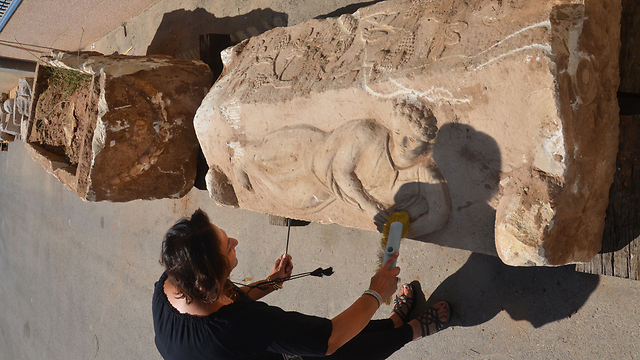
A 1,800-year-old sarcophagus, which workers found at a building site in Ashkelon and initially tried to conceal, was unveiled on Thursday.
The Antiquities Authority (IAA) said it was "one of the most important and beautiful," as well as one of the rarest sarcophagi ever discovered in Israel.
The lid of the two-ton, 2.5 m long limestone coffin features a life-size carving of a human figure wearing a short-sleeved shirt decorated with embroidery on the front and a tunic around his waist.

"The figure’s eyes were apparently inlaid with precious stones that have disappeared and the hair is arranged in curls, in a typical Roman hairstyle," said archaeologist Dr. Gabi Mazor. "On the other side of the lid is a carved relief of a metal amphora (a vessel used for transporting liquids such as wine) from which there are intertwining tendrils bearing grape clusters and grape leaves," he added.

The sarcophagus itself is decorated with, among other things, wreaths and images of bulls' heads, naked Cupids, and the head of the monstrous female figure Medusa which includes remains of hair together with snakes.
Mazor said the piece dates back to the 3rd century and was likely commissioned by a wealthy Roman family.
"Such sarcophagi were usually placed in or next to a family mausoleum. The high level of decoration attested to the family’s affluence, which judging by the depicted motifs was probably not Jewish," he said.

The IAA said the sarcophagus was "severely damaged when building contractors improperly removed it from the ground."
"The sarcophagus was repeatedly struck by a tractor in different places, scarring the stone and damaging the decorations sculpted by an artist on its sides," the IAA said.
Contractors then hid the piece, fearing it would force them to halt work. "(They) pulled it out of the ground with a tractor while aggressively damaging it, concealed it beneath a stack of sheet metal and boards and poured a concrete floor in the lot so as to conceal any evidence of the existence of the antiquities site," the IAA said.
After receiving reports about unlawful activities at the construction site, IAA inspectors and Ashkelon police officers arrived at the site, where they uncovered the sarcophagus and detained five Palestinian construction workers from the Hebron area who were sleeping at the building site.
During their questioning, the detained Palestinians told police the sarcophagus was found a week ago, and showed officers videos and photos of its discovery.
Later that night, police detained two building contractors from Ashkelon who were responsible for the construction work on the site. The contractors were questioned under caution on suspicion of not reporting an ancient discovery and on suspicion of damaging an antiquities site and its artifacts – an offense punishable by five years imprisonment.
"The IAA is attentive to the development needs and the needs of the public, but will strictly enforce the law against those who knowingly damage antiquities, which are assets belonging to us all," said Amir Ganor, head of the Inspection Department at the IAA.
"Legal proceedings will now be taken against those involved, thereby leading to a delay in construction and related expenditures," Ganor added.
The Associated Press contributed to this report.
















